Visit this blog for regular posts about Your Archives: The Histories We Share. Visit the Archives of Manitoba to see the records in person.
November 2020:
- November 27, 2020: Watercolour painting of Fort Dunvegan by Rollin Price Meade — Submitted by Thomas Schultze, author of Hudson’s Bay Company Posts and Depots: Images from a Vanished Era
- November 20, 2020: Records of 4-H Clubs — Submission by Alfred Chorney, amateur historian, Brokenhead Heritage Committee
- November 13, 2020: Records related to brick and limestone — Submission by Peter Schuster, Director, MMI (Manitoba Masonry Institute)
- November 06, 2020: First World War letter written by Lt. Alexander Logan Waugh to his father — Submission by Alexander Waugh, nephew of Lt. Alexander Logan Waugh, grandson of Winnipeg Mayor R.D. Waugh and great-grandson of Mayor Alexander Logan
November 27, 2020
Watercolour painting of Fort Dunvegan by Rollin Price Meade — Submitted by Thomas Schultze, author of Hudson’s Bay Company Posts and Depots: Images from a Vanished Era
“Significance - The image is the only artistic rendition of the establishment [Fort Dunvegan] at HBC Archives. Its circular shape is unusual for a landscape painting. Its diameter of only 14 cm contains a great deal of minute detail.
“Description - Most prominent are the snow-covered hills and their deeply incised valleys and slanted snowdrifts, to the left of the gully, and to its right, the two frozen waterfalls. This surreal-looking hillside hovers above the small settlement, separated from it by rows of trees.
“The fort’s buildings form the standard layout, with a central courtyard open to the river. On the north side the artist shows a major dwelling facing the entrance, the post manager’s residence. The two large subdivided structures along each side are men’s and officer’s dwellings and storage facilities for provisions and agricultural products. Note absence of palisades and bastions.
“The level area between fort and river is blown in with snow, the snow banks repeating the pattern on the hill. One York boat is pulled up on the bank and several canoes can be seen further up. Off to the right can be seen the horse pasture and fields and to the left, an oxcart.
“In the foreground, left, we see an adult person with a child and in the centre, a man leading a draft animal and sleigh. One person carries water to the fort, drawn from a hole in the river ice, while some dogs wait to drink. Other figures can be seen approaching the fort from the riverbank.
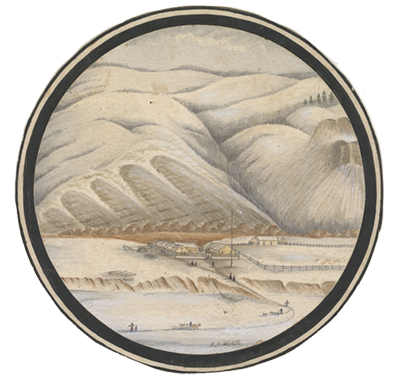
enlarge image
full size
Hudson’s Bay Company Archives, Archives of Manitoba, Fort Dunvegan [Peace River, AB], Watercolour by Rollin Price Meade, ca. 1866, HBCA P-178
“Artist - Rollin Price Meade (1837-1879) was an artist, adventurer, newspaper editor and house painter. In the service of the Hudson's Bay Company, he spent some time in Manitoba and Saskatchewan. Meade painted the first canvas curtain at the historic Walker Theatre in Winnipeg. In 1869, at the time of Louis Riel's Rebellion in Manitoba, he was an artist and the editor of the ‘Nor' Wester’ Newspaper.”
Want to know more? Contact us for more information.
Want to participate in Your Archives? See Submit Your Story for details. You may e-mail us at yourarchives@gov.mb.ca with a comment about this blog post and your comments may be included on this page.
November 20, 2020
Records of 4-H Clubs — Submission by Alfred Chorney, amateur historian, Brokenhead Heritage Committee
“An earlier inquiry to Archives requesting Records of 4-H Clubs in Brokenhead/Beausejour Ag Rep District, yielded a response indicating that there is an abundance of records of club activities in the area. Our intent was to visit Archives to view the details of files. Members of our committee could not make arrangements to date.
“The prime reason for choosing the content of the 4-H files is to identify the Clubs that have been part of the rural youth education programs that were provided through the Manitoba Departments of Agriculture since 1917 – earliest identified Club – through to approximately 1980. The impact of 4-H activities in the district was substantial.”
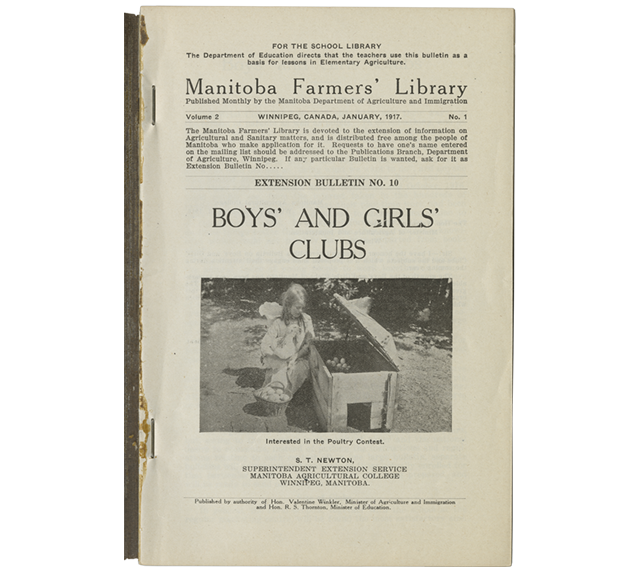
enlarge image
full size
Archives of Manitoba, Manitoba 4-H Council fonds, Brochures – Historical, 1917, P6098/7
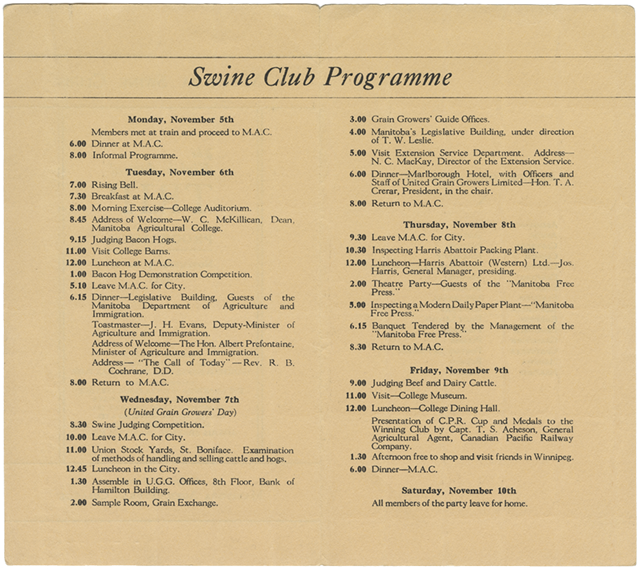
enlarge image
full size
Archives of Manitoba, Manitoba 4-H Council fonds, Brochures/Pamphlets/Programs – Historical, Swine/Pig Clubs, 1928, P6099/8
“Depending on the outcome of the search of the files and our ability to compile historical data along with artifacts, photos etc. acquired from other sources, it would be proposed that a ‘history of 4-H in North-Eastern Manitoba'’ would become part of the Broken-Beau Historical Society's Pioneer Village Museum located in Beausejour.”
Want to know more? Contact us for more information.
Souhaitez-vous participer à Vos archives? Consultez Envoyer votre histoire. Vous pouvez nous envoyer un courriel à yourarchives@gov.mb.ca avec des commentaires à propos de cet article de blogue, et ces commentaires pourraient être ajoutés à cette page.
November 13, 2020
Records related to brick and limestone — Submission by Peter Schuster, Director, MMI (Manitoba Masonry Institute)
“I would like to nominate the simple, yet beautiful building blocks of brick and limestone that helped build the foundations and buildings that our great city is renowned and celebrated for today. Built by skilled local craftsmen and artisans who have passed down their craft and know how, for generations. These same crafts are taught and celebrated in our post secondary institutions to this modern time. These simple materials were skillfully brought together to create housing, offices, warehouses and factories that helped move our society forward through prosperous and sometime turbulent times. All standing the test of longevity with beauty, grace and function. These many buildings tell us a historical story that can be seen and related to by Manitobans to this very day. They continue to functionally adorn even new buildings constructed, with a modern look that help to link us back to our historical roots.
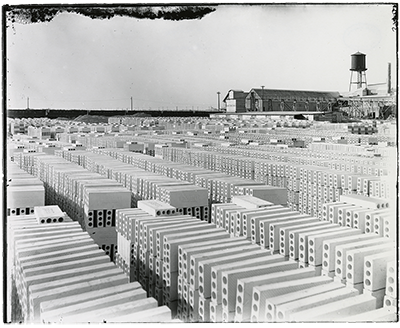
enlarge image
full size
“This is a great choice to help celebrate our 150th anniversary. It not only celebrates the foresight of our leaders, but celebrates the countless many working families of architects, engineers, construction workers and masons who worked diligently together to contribute to a collection of historical and significant buildings and artifacts that permeate our great city to this very day. Going back in time, these were trades learned in other countries and brought by the immigrants, many of whom CHOSE to make Manitoba home. This was all done with many materials that were either made locally, by long forgotten brick manufacturers that dotted the city, but were also quarried locally within the province, some still in operation today. Many of these building stand the test of time and are now treasured and protected for generations to come. Not only do these building give us a unique character for the city and province to celebrate, many are also adorned with unique and historical advertising that remind us to this day of an era not to be forgotten. These materials, made from the abundance of resources located within our great province, have themselves a story to tell within the shapes and patterns of the fossilized remains that helped create them. There are many layers to this story that go well beyond the simple sides of the keystone of our province.
“There are an abundance of examples throughout our province, from the legislative buildings, to almost all buildings in the warehouse district, schools, courthouses and most other buildings that help make a city or province function on a daily basis. Examples can be found in almost any archived photo showing the landscape and fabric of all cities and towns located within our great province. This is a story that can be shared, told and related to by all towns, cities and most importantly Manitobans.”
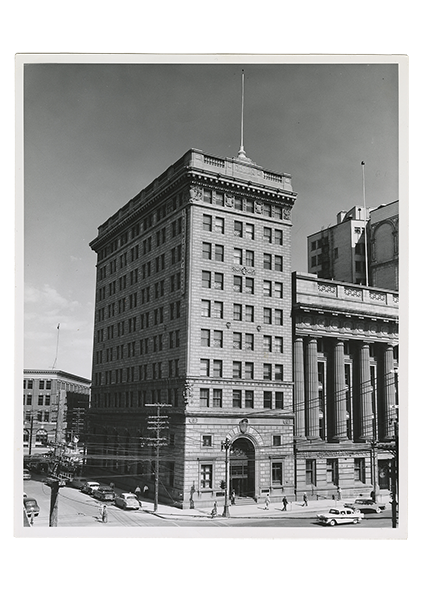
enlarge image
full size
Archives of Manitoba, Winnipeg – Buildings – Business – Hamilton Building 1, 1957
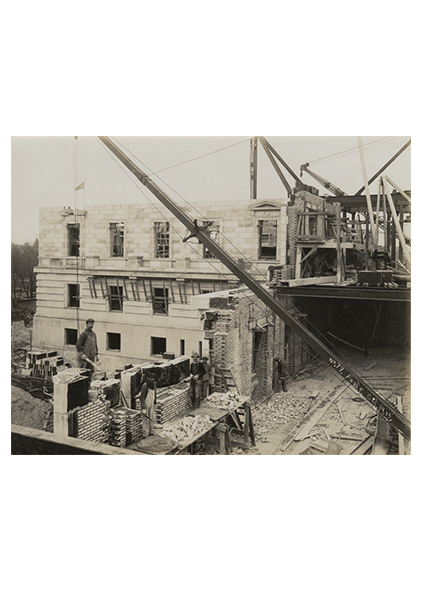
enlarge image
full size
Archives of Manitoba, L.B. Foote fonds, Foote 607. Construction of Leg. Building showing N. side of east of S. wing, 19 October 1915, P7395/1
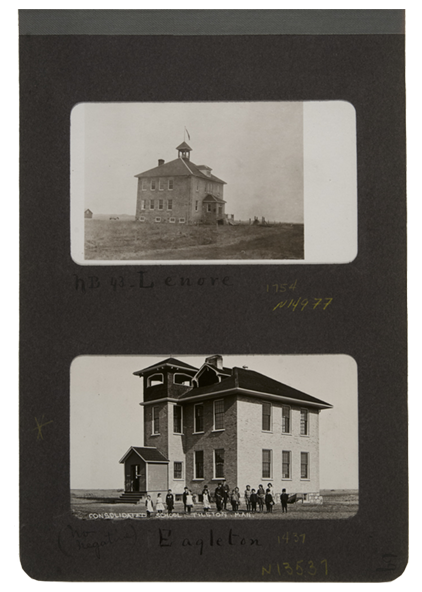
enlarge image
full size
Archives of Manitoba, A 0278 Department of Education photograph album, GR2664, page 69, G 11005
Want to know more? Search Keystone for more information. View more photographs of the construction of the Legislative Building in our online exhibit, The Manitoba Legislative Building: Photographing a Work in Progress.
Want to participate in Your Archives? See Submit Your Story for details. You may e-mail us at yourarchives@gov.mb.ca with a comment about this blog post and your comments may be included on this page.
November 6, 2020
First World War letter written by Lt. Alexander Logan Waugh to his father — Submission by Alexander Waugh, nephew of Lt. Alexander Logan Waugh, grandson of Winnipeg Mayor R.D. Waugh and great-grandson of Mayor Alexander Logan
“His sentiments bespeak a country and Empire united to defend against the Kaiser. He didn't see himself as any special hero but felt for his men and thousands of others for the sacrifices they and their families made to keep Canada and Manitoba free.”
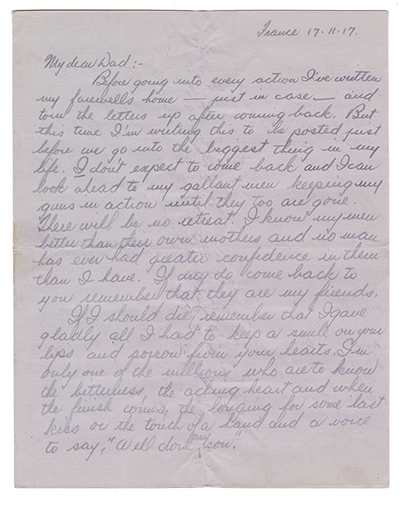
enlarge image
full size
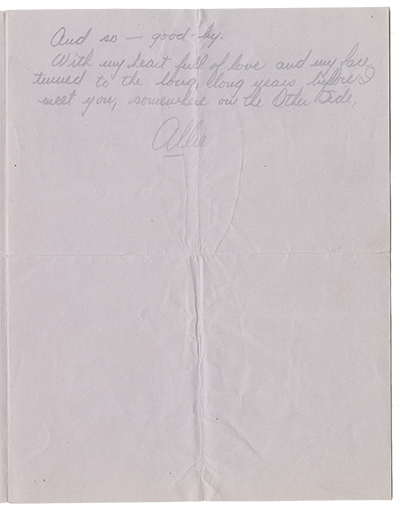
enlarge image
full size
Archives of Manitoba, Waugh family fonds, Letters from Alexander Logan Waugh to his family, July – November 1917, P7965/11
Want to know more? Search Keystone for more information. You can read more about this letter in our previous blog, At Home and Away: Remembering the First World War through records at the Archives of Manitoba. A scrapbook kept by the Waugh family was also featured in our blog.
Want to participate in Your Archives? See Submit Your Story for details. You may e-mail us at yourarchives@gov.mb.ca with a comment about this blog post and your comments may be included on this page.



